一. json格式交互(知道)
1 . 回顾ajax基本语法
$.ajax({ url:"", // 请求的后台路径 data:{"":"","":""} // 请求携带的数据 type:"", // 请求方式 dataType:"json" //接收后台返回数据的解析方式 success:function(data){}//请求成功时的回调函数 })
2. 代码
2.1 测试部分代码
前提:环境搭建
创建web项目--->导入需要的jar包---->配置web.xml---->配置用于获取springmvc容器的配置文件(在web.xml中的前端控制器中加载,并放在conf文件夹里)
补充知识:web-inf下的静态文件的访问
首先,对于外部访问来说,web-inf下的文件都是不可见的(即不能通过url获得web-info下的任何文件),所以,直接访问jsp是不可能的。这要从web-info文件夹的作用说起:
WEB-INF的存在以及其下的lib和classes目录的作用都是jsp规定的,主要是系统运行的配置信息和环境,用来存储服务端配置文件信息和在服务端运行的类文件,它下面的东西不允许客户端直接访问的,这是jsp环境的规定。
而我们通常是使用view层框架(如struts)来提供jsp服务,此时,我们可以将jsp文件放到web-info下避免客户直接访问到页面,同时使用struts来进行jsp文件提取,并将编译好的结果发送到客户端。
所以,此处的js文件不能放进web-inf中,若想放进去需要进行静态资源的配置
项目结构图:
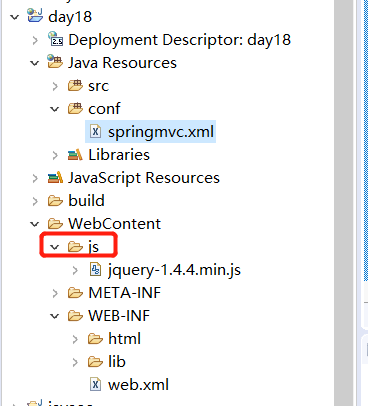
前端代码

<!DOCTYPE html> <html> <head> <meta charset="UTF-8"> <title>Insert title here</title> </head> <script type="text/javascript" src="js/jquery-1.4.4.min.js"></script> <script type="text/javascript"> $(function(){ alert("hello") }) </script> <body> </body> </html>
web.xml文件

<?xml version="1.0" encoding="UTF-8"?> <web-app xmlns:xsi="http://www.w3.org/2001/XMLSchema-instance" xmlns="http://java.sun.com/xml/ns/javaee" xsi:schemaLocation="http://java.sun.com/xml/ns/javaee http://java.sun.com/xml/ns/javaee/web-app_2_5.xsd" id="WebApp_ID" version="2.5"> <display-name>day18</display-name> <welcome-file-list> <welcome-file>index.html</welcome-file> <welcome-file>index.htm</welcome-file> <welcome-file>index.jsp</welcome-file> <welcome-file>default.html</welcome-file> <welcome-file>default.htm</welcome-file> <welcome-file>default.jsp</welcome-file> </welcome-file-list> <!-- 配置前端控制器 --> <servlet> <servlet-name>springmvc</servlet-name> <servlet-class>org.springframework.web.servlet.DispatcherServlet</servlet-class> <!-- 在创建servlet对象时,初始化其值 --> <init-param> <!-- 指定springmvc配置文件的路径,如果不指定,则读取web-inf下 servlet的名称-servlet.xml --> <param-name>contextConfigLocation</param-name> <param-value>classpath:springmvc.xml</param-value> </init-param> <!-- 值大于0,就自动创建servlet实例,数字越小越先加载 --> <load-on-startup>2</load-on-startup> </servlet> <servlet-mapping> <servlet-name>springmvc</servlet-name> <url-pattern>*.do</url-pattern> </servlet-mapping> <!-- 配置post方式的字符过滤器解决中文乱码问题 --> <filter> <filter-name>CharacterEncodingFilter</filter-name> <filter-class>org.springframework.web.filter.CharacterEncodingFilter</filter-class> <init-param> <param-name>encoding</param-name> <param-value>utf-8</param-value> </init-param> </filter> <filter-mapping> <filter-name>CharacterEncodingFilter</filter-name> <url-pattern>/*</url-pattern> </filter-mapping> </web-app>
springmvc.xml

<beans xmlns="http://www.springframework.org/schema/beans" xmlns:xsi="http://www.w3.org/2001/XMLSchema-instance" xmlns:mvc="http://www.springframework.org/schema/mvc" xmlns:context="http://www.springframework.org/schema/context" xmlns:aop="http://www.springframework.org/schema/aop" xmlns:tx="http://www.springframework.org/schema/tx" xsi:schemaLocation="http://www.springframework.org/schema/beans http://www.springframework.org/schema/beans/spring-beans-3.2.xsd http://www.springframework.org/schema/mvc http://www.springframework.org/schema/mvc/spring-mvc-3.2.xsd http://www.springframework.org/schema/context http://www.springframework.org/schema/context/spring-context-3.2.xsd http://www.springframework.org/schema/aop http://www.springframework.org/schema/aop/spring-aop-3.2.xsd http://www.springframework.org/schema/tx http://www.springframework.org/schema/tx/spring-tx-3.2.xsd "> <!--处理器适配器和处理器映射器 json 数据解析组件 --> <mvc:annotation-driven /> <!-- spring的IOC的扫码组件 --> <context:component-scan base-package="com._51doit.controller"/> <!-- 视图解析器 --> <bean class="org.springframework.web.servlet.view.InternalResourceViewResolver"> <property name="prefix" value="WEB-INF/html/" /> <property name="suffix" value=".html" /> </bean> </beans>
PageController

@Controller public class PageController { @RequestMapping("ajax") public String showAjax() { return "ajax_demo"; } }
2.2 代码
2.2.1 ajax
发送的是json对象
$(function(){ // 發送json對象 $("#btn1").click(function(){ $.ajax({ url:"/day18/ajaxDemo.do", data:{"name":"小崔","age":54}, type:"post", dataType:"json", success:function(data){ alert(data) } }) }) // 发送json类型的字符串 $("#btn2").click(function(){ $.ajax({ url:"/day18/ajaxDemo2.do", data:'{"name":"小崔","age":54}', type:"post", contentType:"application/json;charset=utf8", // 指定发送的数据格式,否则后台不知道其是json字符串 dataType:"json", success:function(data){ alert(data.name) } }) }) })
2.2.2 后台controller
接受json对象
@RequestMapping("/ajaxDemo")
@ResponseBody //表示将对象转换成字符串返回
public User getAjax(String name , int age) {//此处也可以直接使用(User user),但是user中的属性名要和前台发送的一致
User user = new User();
user.setName(name);
user.setAge(age);
System.out.println(user);
return user;
}
接受json串数据
@RequestMapping("/ajaxDemo2")
@ResponseBody
public User getAjax2(@RequestBody User user) { // 指定接收的数据格式为json,不然后台user中的属性接收不到前台传来的数据
System.out.println(user);
return user;
}
总结:1,前台页面发送的是json对象的数据,后台控制器直接根据json的属性名直接接收请求参数
@ResponseBody注解可以将对象转换成接送字符串返回
2. 前台页面发送的是json串的数据, 前台指定数据格式,contentType:"application/json;charset=utf8",后台控制器使用注解@RequestBody接收数据
3. 一般页面的请求数据是json对象 , 常用页面请求的是key/value的请求数据,页面常返回json数据
二. Restful(了解)
三 静态资源

/ :拦截(捕获)所有资源,拦截静态资源(图片,js,css),但不会拦截jsp
/*:拦截所有的资源,包括js,css,图片,jsp 但是springmvc对jsp没有处理
注意:后面在ssm整合代码处的web.xml文件中使用/*去匹配会报404错误
如,当请求js文件夹下的demo2.html,会报404错误,如下图
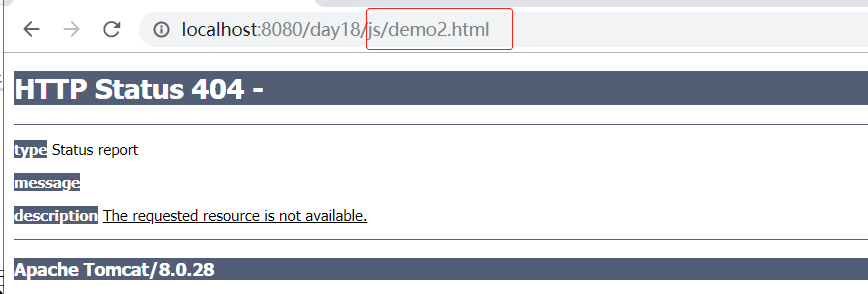
在springmvc容器的配置文件中配置静态资源映射就能请求到这个资源(不会报错)
如果将DispatcherServlet请求映射配置为"/"(如上圈中),则Spring MVC将捕获Web容器所有的请求,包括静态资源的请求,Spring MVC会将它们当成一个普通请求处理,因此找不到对应处理器将导致错误。
如何让Spring框架能够捕获所有URL的请求,同时又将静态资源的请求转由Web容器处理,是可将DispatcherServlet的请求映射配置为"/"的前提。解决:配置静态资源的映射

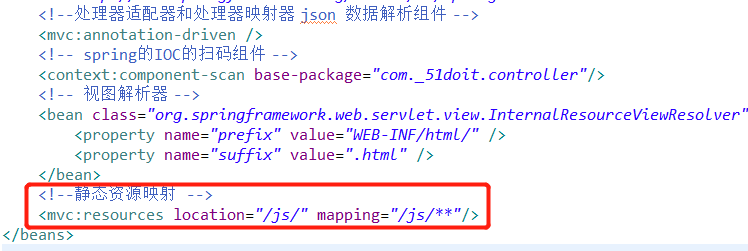
四 SSM
1. 整合思想:
springmvc:
加载web.xml,创建前端控制器(接收页面请求并返回页面)--->创建spring容器(会自动加载相应的配置文件(application.xml),以前是创建springmvc,此处直接创建spring容器,将springmvc用到的三大组件配置在spring容器中)--->扫描controller,service(在springmvc中是只扫描controller即可),这样就完成了spring和springmvc的整合
spring
mybatis(全局配置文件和核心映射文件+mapper接口)
(1)全局配置文件:别名 (数据源 mapper,这两个不需要)
创建SqlSessionFactory对象,交给spring管理,其中需要提供数据源对象,以及全局配置文件(通过property给配置路径)
(2)核心映射文件+mapper接口
可以直接创建一个对象去管理核心映射文件+mapper接口,让其生成代理对象

2. application.xml(ssm整合的配置文件

<?xml version="1.0" encoding="UTF-8"?> <beans xmlns="http://www.springframework.org/schema/beans" xmlns:xsi="http://www.w3.org/2001/XMLSchema-instance" xmlns:aop="http://www.springframework.org/schema/aop" xmlns:context="http://www.springframework.org/schema/context" xmlns:mvc="http://www.springframework.org/schema/mvc" xmlns:tx="http://www.springframework.org/schema/tx" xsi:schemaLocation="http://www.springframework.org/schema/beans http://www.springframework.org/schema/beans/spring-beans.xsd http://www.springframework.org/schema/aop http://www.springframework.org/schema/aop/spring-aop-4.1.xsd http://www.springframework.org/schema/context http://www.springframework.org/schema/context/spring-context-4.1.xsd http://www.springframework.org/schema/mvc http://www.springframework.org/schema/mvc/spring-mvc-4.1.xsd http://www.springframework.org/schema/tx http://www.springframework.org/schema/tx/spring-tx-4.1.xsd"> <!-- mybatis --> <!-- 数据源 数据库连接池,四个参数--> <bean id="dataSource" class="com.mchange.v2.c3p0.ComboPooledDataSource"> </bean> <!-- 加载全局配置文件,创建SqlSessionFactory对象,需要数据源信息 --> <bean id="sqlSessionFactory" class="org.mybatis.spring.SqlSessionFactoryBean"> <!-- 配置数据库连接池 --> <property name="dataSource" ref="dataSource" /> <!-- 加载配置文件 --> <property name="configLocation" value="classpath:SqlMapConfig.xml" /> </bean> <!-- mapper管理对象 生成代理 扫描mapper包 --> <bean class="org.mybatis.spring.mapper.MapperScannerConfigurer"> <!-- 指定扫描的包 --> <property name="basePackage" value="com._51doit.dao" /> <!-- 注入SqlSessionFactory --> <property name="sqlSessionFactoryBeanName" value="sqlSessionFactory"></property> </bean> <!-- service层 --> <!-- 事务 所有的事务是通过 事务管理器 管理的 在service 业务层的方法上开启或者关闭事务 save(){ 开启 dao.jian() dao.jia() 提交 } 方法 dao方法 --> <!-- 配置事务 --> <!-- 事务管理器,对mybatis操作数据库进行事务控制,此处使用jdbc的事务控制 --> <bean id="transactionManager" class="org.springframework.jdbc.datasource.DataSourceTransactionManager"> <!-- 指定要进行事务管理的数据源 --> <property name="dataSource" ref="dataSource"></property> </bean> <!-- 配置切面 --> <tx:advice id="transactionAdvice" transaction-manager="transactionManager"> <tx:attributes> <tx:method name="save*" propagation="REQUIRED" /> <tx:method name="delete*" propagation="REQUIRED" /> <tx:method name="update*" propagation="REQUIRED" /> <tx:method name="get*" propagation="SUPPORTS" read-only="true" /> <tx:method name="find*" propagation="SUPPORTS" read-only="true" /> <tx:method name="*" propagation="REQUIRED" /> </tx:attributes> </tx:advice> <aop:config> <!-- execution表达式 --> <!-- * 是否有返回值 --> <!-- cn.edu360.service..*Impl cn.edu360.service这个包及其子包下的以Impl结尾的类 --> <!-- *(..))类下的任务方法 ,是否有参数 --> <aop:pointcut id="transactionPointcut" expression="execution(* com._51doit.service.*Impl.*(..))" /> <aop:advisor pointcut-ref="transactionPointcut" advice-ref="transactionAdvice" /> </aop:config> <!-- springmvc --> <!-- 三大组件 --> <mvc:annotation-driven /> <bean id="viewResolver" class="org.springframework.web.servlet.view.InternalResourceViewResolver"> <property name="prefix" value="/WEB-INF/pages/" /> <property name="suffix" value=".jsp" /> </bean> <mvc:resources location="/" mapping="/**"></mvc:resources> <!-- 包扫描 service controller --> <context:component-scan base-package="com._51doit.*" ></context:component-scan> </beans>
2.1 第一部分:头部信息

这个头部信息表示声明和下面标签的约束
2.2 第二部分:mybatis
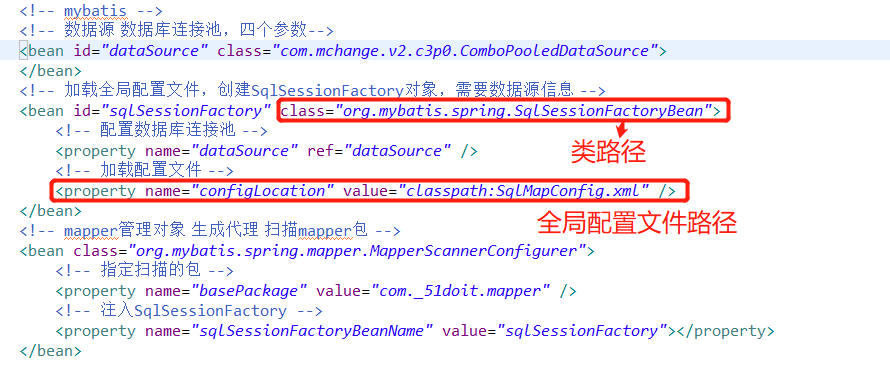
2.3 第三部分:service层
所有的事务是通过事务管理器管理的,在service业务层的方法上开启或者关闭事务
save(){ 开启 dao.jian() dao.jan() 提交 }
(1)配置事务

(2)配置切面
补充知识:<tx:advice><tx:advice />配置详解
http://jinnianshilongnian.iteye.com/blog/1442376(此作者写了声明式非声明式编程,有空可以去学下)
声明式事务管理通过配置<tx:advice><tx:advice />来定义事务属性,配置方式如下
<tx:advice id="……" transaction-manager="……"> <tx:attributes> <tx:method name="……" propagation=" REQUIRED" isolation="READ_COMMITTED" timeout="-1" read-only="false" no-rollback-for="" rollback-for=""/> …… </tx:attributes> </tx:advice>
(a) <tx:advice>:
id用于指定此通知的名字, transaction-manager用于指定事务管理器,默认的事务管理器名字为“transactionManager”;
(b)< tx:attributes >: 指定具体需要拦截的方法
(c)<tx:method >:用于定义事务属性
name:定义与事务属性相关联的方法名,将对匹配的方法应用定义的事务属性,可以使用“*”通配符来匹配一组或所有方法,如“save*”将匹配以save开头的方法,而“*”将匹配所有方法;
propagation:事务传播行为定义,默认为“REQUIRED”,表示Required,其值可以通过TransactionDefinition的静态传播行为变量的“PROPAGATION_”后边部分指定,如“TransactionDefinition.PROPAGATION_REQUIRED”可以使用“REQUIRED”指定;
isolation:事务隔离级别定义;默认为“DEFAULT”,其值可以通过TransactionDefinition的静态隔离级别变量的“ISOLATION_”后边部分指定,如“TransactionDefinition. ISOLATION_DEFAULT”可以使用“DEFAULT”指定:
timeout:事务超时时间设置,单位为秒,默认-1,表示事务超时将依赖于底层事务系统;
read-only:事务只读设置,默认为false,表示不是只读;
rollback-for:需要触发回滚的异常定义,以“,”分割,默认任何RuntimeException 将导致事务回滚,而任何Checked Exception 将不导致事务回滚;异常名字定义和TransactionProxyFactoryBean中含义一样
no-rollback-for:不被触发进行回滚的 Exception(s);以“,”分割;异常名字定义和TransactionProxyFactoryBean中含义一样;

2.4 第四部分:springmvc

3. 整合
(1)导入jar包
(2)配置文件
log4j.properties;SqlMapConfig.xml全局配置文件 只需别名;c3p0.properties;application.xml
(3)持久层(3个bean,数据源,SqlSessionFactory,mapper)
(4)service声明式事务
(5)配置springmvc的三大组件和包扫描(在application.xml中配置)
项目大致框架
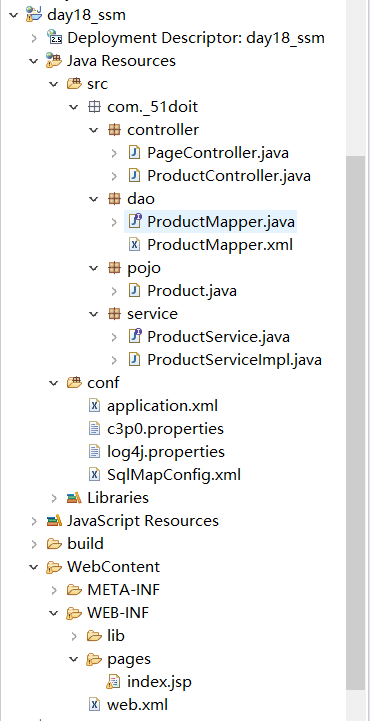
controller层
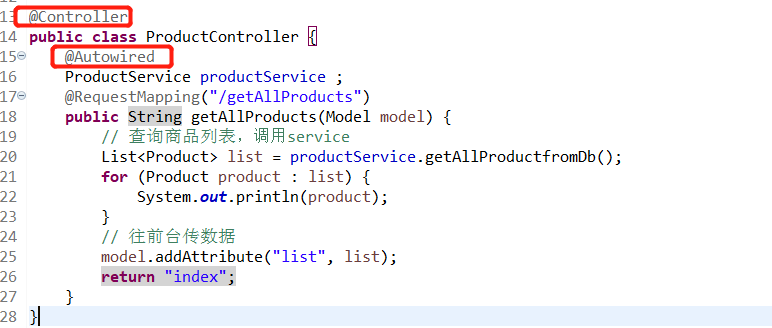
dao层
ProductMapper

public interface ProductMapper { // 获取产品信息 public List<Product> getAllProducts(); }
ProductMapper.xml

<?xml version="1.0" encoding="UTF-8" ?> <!DOCTYPE mapper PUBLIC "-//mybatis.org//DTD Mapper 3.0//EN" "http://mybatis.org/dtd/mybatis-3-mapper.dtd"> <mapper namespace="com._51doit.dao.ProductMapper"> <select id="getAllProducts" resultType="product"> select * from products </select> </mapper>
pojo

package com._51doit.pojo; public class Product { private int id; private String name ; private double price ; private String category ; private int pnum ; private String description ; public int getId() { return id; } public void setId(int id) { this.id = id; } public String getName() { return name; } public void setName(String name) { this.name = name; } public double getPrice() { return price; } public void setPrice(double price) { this.price = price; } public String getCategory() { return category; } public void setCategory(String category) { this.category = category; } public int getPnum() { return pnum; } public void setPnum(int pnum) { this.pnum = pnum; } public String getDescription() { return description; } public void setDescription(String description) { this.description = description; } @Override public String toString() { return "Product [id=" + id + ", name=" + name + ", price=" + price + ", category=" + category + ", pnum=" + pnum + ", description=" + description + "]"; } }
service
注意:此处别忘了在实现类上方加@service
ProductService

public interface ProductService { // 从数据库获取信息 public List<Product> getAllProductfromDb(); }
ProductServiceImpl

@Service public class ProductServiceImpl implements ProductService{ @Autowired ProductMapper pMapper ; @Override public List<Product> getAllProductfromDb() { return pMapper.getAllProducts(); } }
4. 练习:
使用ssm框架完成增删改查,若没有登录则不能进行增删改查,并登录然后进行相应的操作
